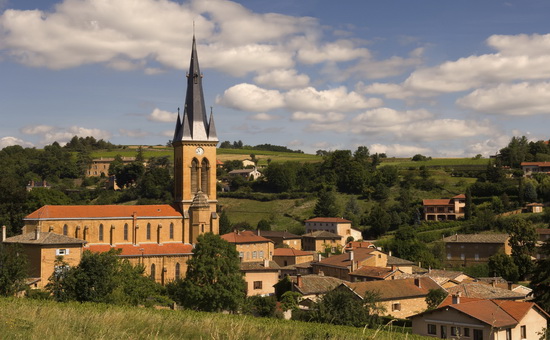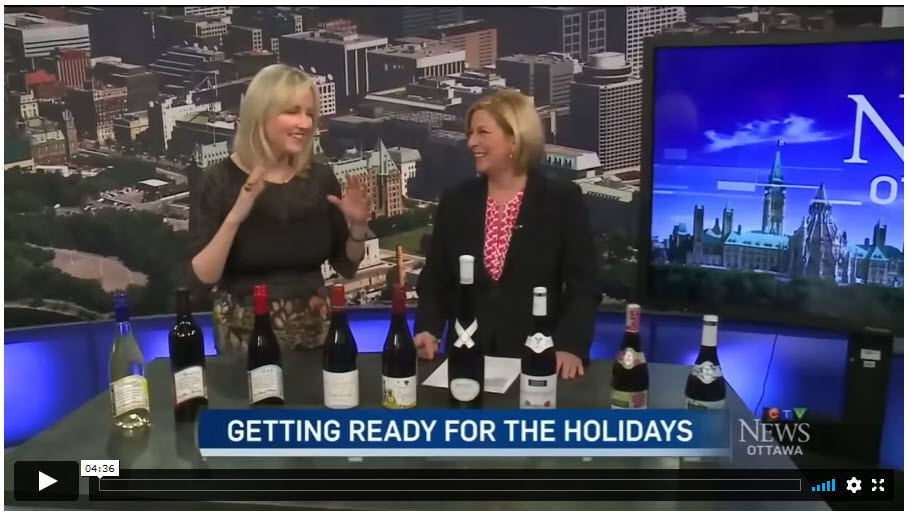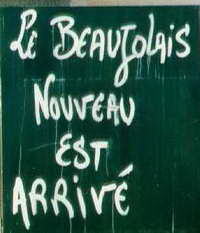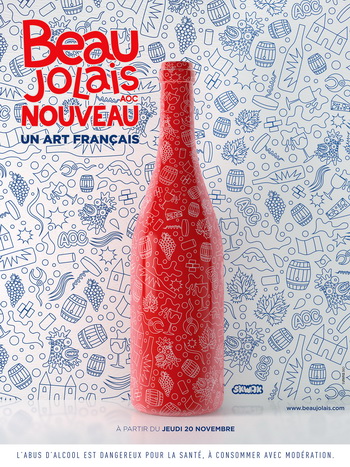Carol Anne and I chat about this year’s beaujolais nouveau in the video above. Catch our second video chat about more easy-drinking red wines for the holidays that aren’t nouveau.
The annual release of Beaujolais Nouveau and other nouveau wines happens on the third Thursday of November. According to several liquor store chains, they are one of the fastest-selling products with about 80% selling out during the first week.
In the LCBO, there are usually two Ontario nouveau wines (Reif), five French and two Italian nouveau-style (novello) wines released, and a total of more than 10,000 cases sold. The Beaujolais Nouveau wines can’t buy until midnight Thursday, so Friday morning really when liquor stores open.
Here are my previous reviews and ratings of the Beaujolais Nouveau wines, French Primeur, Italian Novellos and Canadian nouveau-style wines as we can’t taste the new vintage until midnight Thursday:
The Fool Reif Estate Gamay Nouveau VQA, Ontario
The Hanging Man Reif Estate Kerner Nouveau VQA, Ontario
Art’s Beaujolais Primeur Nouveau, France
Catalans Primeur Syrah Merlot, France
Negrar Novello Del Veneto, Italy
Tollo Novello Rosso Terre di Chieti, Italy
Mommessin Beaujolais Nouveau, France
Joseph Drouhin Beaujolais Villages Nouveau, France
George DeBoeuf Gamay Nouveau, France
George DeBoeuf Beaujolais Villages Nouveau, France
The madness starts at one minute past midnight on the third Thursday of November, when beaujolais nouveau is officially released. More than half of the 60 million bottles of this French red wine leave their native villages in southern Burgundy to begin the journey by plane, ship, train, truck, motorcycle, elephant, rickshaw and foot to wine lovers around the world.
Only weeks before, this hot-off-the-press wine was still gamay grapes clustered on local vines. But the Beaujolais vintners work feverishly fast to harvest, ferment and bottle the juice so it’s ready for the midnight hour.
The worldwide release of beaujolais nouveau is an extraordinary feat of coordination and marketing. Because of differing time zones, the nouveau is jetted to each country just a few days before its official release at local time. But since most liquor stores around the world are closed at one minute after midnight, most of us have to wait at least until the next morning to sample the new harvest.
In fact, one beaujolais vintner recommends drinking his wine, the day after bottling, with breakfast. Parisians, of course, get to drink it the moment it’s released. French merchants who sell nouveau before its official release are fined $250 per bottle but, outside France, most retailers simply sign an agreement not to do so.
Beaujolais nestles in the rolling hills of southern Burgundy just north of the medieval city of Lyon, where the Rhône, the Saône and the Beaujolais rivers converge. (That’s a local joke: there is no Beaujolais river – just a flood of red wine, some 90 million litres produced annually.) Drinking nouveau started here as an event to celebrate the end of the harvest.
Festivities included floating barrels down the Saône to Lyon. From the quay, barrels were rolled to tents pitched in the center of the city, where celebratory wine tasting, dancing and fireworks lasted for three days. Word of this exuberantly fruity wine spread to Paris, where bistros would serve it in carafes and post window signs proclaiming, “Le beaujolais nouveau est arrivé!” By 1985 the celebration had spread around the world.
 The Official Beajolais Nouveau Poster for 2009
The Official Beajolais Nouveau Poster for 2009
The quality of beaujolais nouveau has traditionally been thought of as an indication of the calibre of the rest of the vintage, which remains aging in barrels until it’s bottled the following spring. In fact, some tipplers regard nouveau as a harbinger of the entire French vintage, even though the country’s many microclimates do not entirely justify this assumption.
The marketing makeover from quaint local custom to a fashionable global drink has boosted the wine’s popularity — not to mention its cash flow, since winemakers can get an immediate return for the harvest, rather than having to wait until the wine matures.
Instead of trying to compete with the more elegant red burgundies made from the pinot noir grape, beaujolais vintners decided to emphasize the strengths of the gamay grape and make a virtue out of youthful wine. Beaujolais nouveau is appreciated as a wine to be quaffed in the spirit of the celebration, with none of the usual sniffing and sipping reserved for more complex wines. If bordeaux is a structured Bach overture and burgundy a romantic Beethoven sonata, then beaujolais is an infectious folk tune that gets your toes tapping.
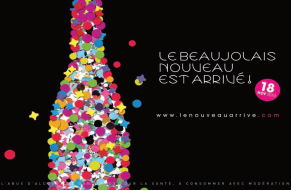 The Official Beajolais Nouveau Poster for 2010
The Official Beajolais Nouveau Poster for 2010
Another reason to drink the new wine early is the nature of the gamay grape, full of rustic vigour that is different from other French grapes. So different are they that in 1395 Philip the Bold, Duke of Burgundy, branded them “wicked and disloyal” and ordered all the vines uprooted. Fortunately, his purge wasn’t successful. Six centuries later, we delight in drinking a wine that’s like fresh fruit, or, as the French say, like “a bouquet of field flowers in a velvet-lined basket.”
But as the wine ages past six months, the bright fruit character tends to fade. So quench your thirst early to capture those vivacious raspberry and cherry flavours. Beaujolais has often been called the only white wine that’s red: its refreshing lightness is similar to white wine, as is the fact that it’s served chilled at about 16°C.
The secret to nouveau’s vibrant character is a winemaking technique called carbonic maceration. In vogue since the 1960s, it differs from traditional methods. Instead of crushing the grapes before fermenting them, whole clusters are fermented, thereby reducing the contact between the juice and the tannic skin and seeds.
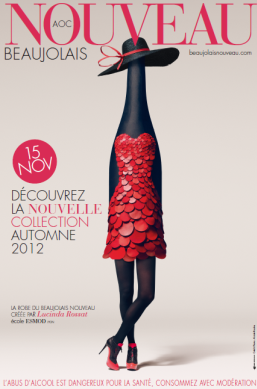 The Official Beajolais Nouveau Poster for 2012
The Official Beajolais Nouveau Poster for 2012
The resulting wine has low tannins, deep colour and incredible fruitiness with a distinctive banana smell. This toute suite technique also means the wines don’t age well and should therefore be consumed within six months of their release. (One advantage: at least you don’t have to memorize any vintage charts.)
Only half of the wine produced in Beaujolais is released as nouveau, and it’s only produced in two of the region’s three districts: Beaujolais, the basic appellation that makes the majority of the wine; and the higher-quality Beaujolais-Villages. The third and highest level, Beaujolais crus, comprises the output of ten villages that produce world-class wines, best drunk after a couple of years in the cellar: Brouilly, Chénas, Chiroubles, Côte de Brouilly, Fleurie, Juliénas, Morgon, Moulin-à-Vent, Régnié and St-Amour.
The cru wines are released after having done their “Easter duty” of resting in the barrel until the spring. However, Morgon and Moulin- à -Vent have been known to age up to ten years with distinction, at which point they can be as fine as Burgundian pinot noir of the same age.
Beaujolais nouveau owes much of its fame to Georges Duboeuf, dubbed by the media as the “King of Beaujolais”. A passionate promoter of the wine, Duboeuf controls 10% of beaujolais production; and his wines, with their floral labels, are available in most countries. Other reputable labels to try are Bouchard Aîné, Joseph Drouhin, Louis Jadot, Jaffelin, Mommessin and Rodet. With prices generally in the range of $8 to $15 range, nouveau is one of the best values on the shelf.
All that’s nouveau isn’t beaujolais, however. Many other regions of France, such as Touraine, Ardèche and Languedoc-Roussillon, also make nouveau-style wine, often using gamay grapes and carbonic maceration. Modern stabilizing techniques have enabled nouveau to be produced from heartier grapes, such as syrah and merlot, without sacrificing the spirited character.
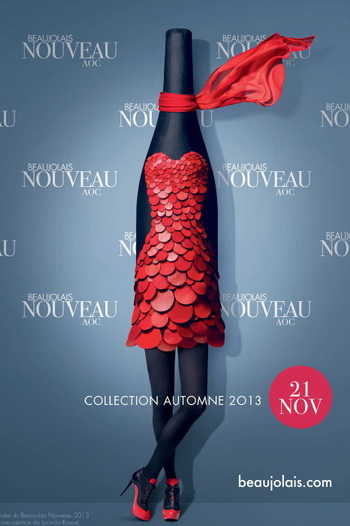 The Official Beajolais Nouveau Poster for 2013
The Official Beajolais Nouveau Poster for 2013
JeanJean Syrah Primeur and JeanJean Saveurs d’Automne Syrah, Vin de Pays d’Oc from southern France have more body than beaujolais, but still offer the essence of bright red berries.
The concept of “new” wine isn’t even confined to France. Italy offers novellos from grapes such as teroldego and lagrein. Reputable producers include Cavit Atesino Novello, Mezzacorona Vino Novello Atesino, Negrar Valpolicella Vino Novello del Veneto.
Even the New World makes nouveau – and respects the French tradition of releasing it in November. Well-known Californian wineries such as Beringer, Fetzer, Sebastiniani and J. Lohr use gamay grapes or else they blend pinot noir, valdiguie and syrah.
Ontario nouveaus include Château des Charmes Gamay Nouveau and Pelee Island Gamay Noir Nouveau. These too are bursting with raspberries, cherries and refreshing acidity.
Another reason to drink nouveau is that it’s one of the most food-friendly of wines. It was a traditional bistro drink, after all, and so it complements bistro fare such as simple roast chicken, smoked ham, salmon, cold cuts, salads or pasta. On its own, it’s one of the most easily quaffable wines. In fact, beaujolais nouveau makes a great transitional wine for anyone wanting to move from white to red wines. And it’s ideal for anyone who’s tired of tannic cabernet sauvignons, or who gets headaches from them.
The Official Beajolais Nouveau Poster for 2014
Beaujolais nouveau allows us one last sip of summer before winter settles in. This carefree wine slips past an analytical mind and goes directly to the heart of happiness.
Natalie MacLean can be reached at [email protected].
SIDEBAR: BEAUJOLAIS BY THE NUMBERS
• Nine grape bunches are used to make one bottle of wine.
• The total weight of the Beaujolais nouveau bottles produced is 43,000 tons.
• The bottles make their initial journey out of the villages in 2,000 trucks.
• 450 airplanes carry 5,500 tons of bottles to their final destination.
• Those that travel by train are stacked in 23 palettes of 50 cases.
SIDEBAR: READ MORE ABOUT BEAUJOLAIS
• The Country Wines of Burgundy & Beaujolais by Patrick Delaforce
• Hachette Wine Guide: Buyer’s Guide To French Wine, Sterling Publishing
• The Winemaker’s Year in Beaujolais by Michael Buller
• Beaujolais: The Complete Guide by Guy Jacquemont by Paul Mereaud
• Visit the web site: www.beaujolais.net/eng/page.htm
SIDEBAR: BISTRO FARE WITH BEAUJOLAIS
• Bistro (Menus and Music) by Sharon O’Connor
• Bistro: The Best of Casual French Cooking (The Casual Cuisines of the World) by Gerald Hirigoyen
• Bistro Cooking by Patricia Wells, Judy Kleiber Jones
• Burgundy Gastronomique by Olivia Callea, Hamish Park (Photographer), Anne Willan
• Cafe Beaujolais by Margaret S. Fox, John Bear
• Evening Food : Cafe Beaujolais by Christopher Kump, Margaret Fox (Contributor), John Bear, Marina Bear (Contributor)
Posted with permission of CTV.
Reif Estate Winery The Fool Gamay Nouveau 2016
Niagara, Ontario V.Q.A., Canada
Reif Estate Winery Hanging Man Kerner Nouveau 2016
Niagara River, Ontario V.Q.A., Canada
J.P. Chenet Art’s Primeur Nouveau Gamay 2016
Beaujolais, France
Catalans Primeur Syrah Merlot 2014
Roussillon, France
Negrar Novello 2016
Veneto, Italy
Tollo Novello Rosso Terre Di Chieti 2016
Abruzzo, Italy
Mommessin Beaujolais Nouveau 2016
Burgundy, France
Joseph Drouhin Primeur Beaujolais Villages Nouveau 2016
Burgundy, France
Georges Duboeuf Gamay Nouveau 2016
Beaujolais, Franc
Georges Duboeuf Beaujolais Villages Nouveau 2016
Burgundy, France
Laurence et Rémi Dufaitre Vin de France Gamay Nouveau 2016
France
Damien Coquelet Vin de France Nouveau Gamay 2016
France
France
Georges Duboeuf Brouilly 2014
Beaujolais AOC, France
Mezzacorona Novello 2016
Alto Adige, Trentino, Italy
Georges Duboeuf Beaujolais Nouveau 2016
Beaujolais, France
Georges Duboeuf Vin de Pays l’Ardèche Gamay 2015
Rhône-Alpes IGT, France
Georges Duboeuf Gamay 2014
Beaujolais-Villages AOC, France
Georges Duboeuf Beaujolais 2014
Beaujolais AOC, France
Georges Duboeuf Fun Gamay 2014
Beaujolais, France
Sirius Merlot Cabernet 2014
Bordeaux, France
Stéphane Aviron Gamay Nouveau 2016
France
Pierre-Marie Chermette Les Griottes Gamay Nouveau 2016
France
Bring on Beaujolais! A Young Red Wine is Centre of Attention each November
Michael: Well, Carol Anne is in for Leanne today and she’s with wine writer extraordinaire, Natalie MacLean. What are you serving up today ladies?
Carol Anne: Well, Michael, Natalie has brought in a whole bunch of bottles of red wine. They can’t be opened until Thursday.
Natalie: Exactly, the French wine police will be after us, they are under embargo. It’s the Beaujolais Nouveau which starts on the third Thursday of every November. You can’t open it before then. It’s a wine to be coiffed in the spirit of celebration.
Carol Anne: And there’s a great tradition behind the Beaujolais Nouveau?
Natalie: There is. These grapes of the wine in the bottles, here, were grapes on the vines a few weeks ago. So it’s bottled tout suite.
Carol Anne: Yes.
Natalie: And it’s jetted out around the world in 450 planes, 2000 trucks and I don’t know how many Rickshaws. You can’t open it until one minute past midnight this Thursday. What’s different about these wines is that they are sort of a harbinger of the harvest. They’re telling you what the wines are going to be like this year. These wines are very young, very fruity, very juicy. These aren’t the wines that you’re sniffing and sipping and analyzing, you’re quaffing these.
Carol Anne: Is this a wine you want sip?
Natalie: . You could if you wanted to. But you know anybody seeing you sniff and sip of Beaujolais Nouveau would probably wonder what you are up to. This whole tradition started with George DeBoeuf, who is most famous for Beaujolais Nouveau.
Carol Anne: This one here?
Natalie: The 2 on the end, there. He’s called “The King of Beaujolais.” He is a very savvy wine maker in Beaujolais which is the Southern region of Burgundy. He figured out how to bottle the Gamay grape very quickly and get cash flow going because for winemakers a lot of their wines sit in barrels all winter.
Carol Anne: Making nothing.
Natalie: Exactly. They’re aging which is necessary for certain styles but for this one he figured, “Let’s have a celebration. The harvest is over, let’s bottle some of this and get some cash flowing.” So they would ship this new wine up to the Paris bistros and soon this celebration, at one minute past midnight, spread around the world.
Carol Anne: It spread as far as Canada because you brought some Canadian versions
Natalie: I did. So from Reif Winery in Niagara, they have The Fool and it is great.
Carol Anne: The fool?
Natalie: It’s called The Fool.
Carol Anne: Okay.
Natalie: So it’s a wine that you should not take seriously. It’s made in a light red style. You’ll notice the vintage is 2014. It’s bottled quickly. It’s meant to be just knocked back.
Carol Anne: Now is it good?
Natalie: Well, good, how do you define good? It is great for celebrations, it is great for celebrating and drinking quickly. It’s not going to age in the cellar. One measure of good wine is, ‘does it age?’ This doesn’t and it shouldn’t. You should drink this, ideally, within 6 months … probably on Thursday…
Carol Anne: That’s soon.
Natalie: Yes, that soon and you could have it with holiday turkey. They call Beaujolais Nouveau, the world’s first breakfast wine because you should drink it that early. So it releases at midnight and have it with your pancakes.
Carol Anne: Are all these wines comparable in quality?
Natalie: They are. They’re very reputable, you have Mommessin and you have Joseph Drouhin. Now what I’ve clustered in amongst the Beaujolais Nouveau are some non Nouveau wines by the same producers. We have George DeBoeuf here and this would be a wine that ages until Easter or April. They call it doing their Easter duty. They’re the Beaujolais Crew which are not Nouveau. They will age and they’re much more of the sipping wine with your Easter Lamb. So they’re different. The Beaujolais Nouveau accounts for less than half of the total yield.
Carol Anne: Okay, so this makes way for a more quality wine later on.
Natalie: Exactly. So they’re treated very differently. Beaujolais Nouveau is even fermented differently. They take the whole berry cluster of fruit and fermented it so that it gets very little skin contact. The skin of the grape, like any fruit, is where all the tannin is …
Carol Anne: Yes.
Natalie: … and the colour in the pigment.
Carol Anne: There you go, that’s your lesson on Beaujolais Nouveau and none of these bottles is going to be opened until Thursday. We’re going to take a short break and when Natalie comes back, we’re going to talk about seasonal wine because we are heading into …
Natalie: … party season.
Carol Anne: Okay Natalie, thank you.
Posted with permission of CTV.



